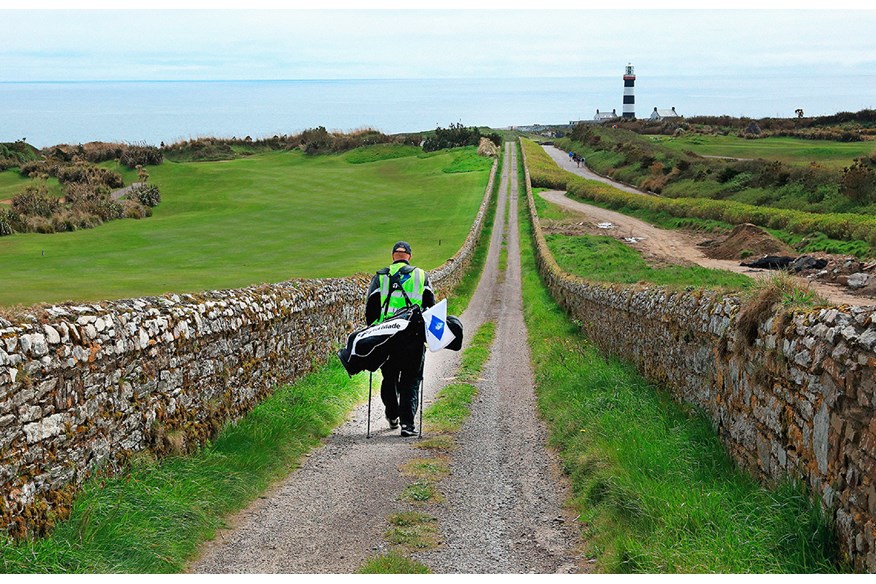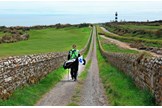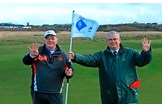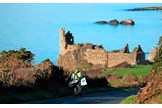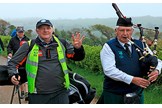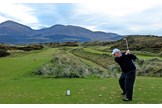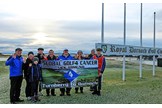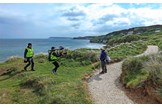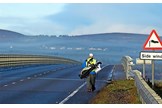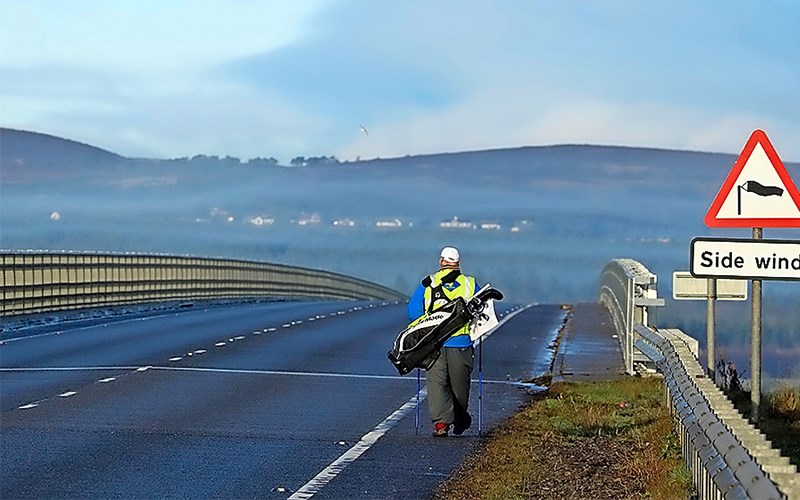Nick Edmund: The long road to recovery
Last updated:
Nick Edmund has walked nearly 2,000 miles carrying his golf bag around Scotland and Ireland. He’s played the 4th hole on 85 of the best courses, each time flying the flag (quite literally) for fellow cancer sufferers and raising money to fight the disease…
Nick Edmund is remarkably upbeat for a man who, just hours earlier, was undergoing yet another course of radiotherapy treatment. It’s a situation he’s been in before, just eight months earlier in fact. Not that it makes it any easier.
“I’ve been in the wars again,” he says, as he tries to make light of his fourth cancer diagnosis in the last six years. It’s a cruel twist of fate, since few have raised as much awareness – or money – for the very disease he is trying to fight. Three times he has completed golfing walks for various charities, and three times he has beaten cancer. He even has the scars to show for it.
One on his forehead, another across his scalp and a third on his neck. He is, in many ways, a walking miracle. In March this year, the one-time barrister, author of 27 golf books and former managing director of Nick Faldo’s course design company, was wandering the streets of Northern Ireland, walking from course to course – 20 in total – just so he could play the 4th hole.
Why? So he could promote his GlobalGolf4Cancer campaign. It’s all part of a bigger mission to get the worldwide golfing community to support various cancer charities and for clubs to fly a GlobalGolf4Cancer flag at least four times every year (on January 4, April 4, July 4 and October 4).
There are, as he points out, four million people affected by cancer in the UK. The disease has four stages. One in four people are directly or indirectly affected by it during their lifetime. In golf, people shout ‘fore’. Two of the most popular formats are fourballs and foursomes. There are four major championships…
These are the reasons why he started the first of four walks in the Republic of Ireland on March 4, 2017. Or, as he likes to joke, ‘march forth’. He continued the theme for his second tour, which began at 4.44pm, and for his most recent effort which lasted four weeks. Each time he has trekked hundreds of miles, stopping only to undergo major surgery and radiotherapy.
When he did, he was back on the road three days later, carrying the same walking poles and overflowing golf bag with his clothes, iPad and belongings inside.
“As far as I’m concerned, the show must go on,” he says, defiantly. After his first cancer diagnosis, doctors gave him a 50/50 chance of beating it. His odds are better this time around, though he may never regain sight in his left eye. He has already undergone two rounds of surgery; one to remove a tumour above it, the other to undergo reconstruction.
“It’s all a bit frustrating and debilitating, to put it mildly,” he adds.
When he finishes his latest programme of treatment on August 30, he will have completed 100 rounds of radiotherapy since 2014 – a fact he shrugs off as being “part of the story”. “
Without sounding too cliché, everything I’ve been through only makes me more determined,” says Edmund, who’s been married to Teresa for 31 years. The couple have two sons, George and Max.
“Being affected by cancer again has made life more difficult, but the best way for me to fight it, quite frankly, is to keep going with my campaign. It’s a positive in my life and that’s important.”
Before the end of the year, his goal is to add Spain, Brazil, Argentina and Chile to the list of countries he’s conquered. He’s already mapped out a route, which starts in Madrid on October 1 and ends in Santiago 17 days later. Along the way, he hopes to fly the flag at the Olympic golf course in Rio, and on the 4th hole at Real Golf de Pedreña, where Seve Ballesteros learned to play the game, with Jose Maria Olazabal and at least one of Seve’s two sons.
Whether he is able to or not is a decision which remains out of his hands. He’s already had to delay his latest campaign in the US and Canada until July next year, and is now waiting to hear if he needs to go under the knife again. The uncertainty of it all is what wrangles him most, yet he refuses to feel any bitterness.
“If you want to build an awareness campaign, stories are what help and drive it,” says Edmund, who hails from Devon. “Me being a cancer sufferer helped remove the question of why I was doing all this and opened some doors. I’ve turned that into kind of a positive.”
When he first had the idea in 2012, he was cancer-free and “looking for something new to do” after leaving behind his job of 15 years as managing director of Faldo Design.
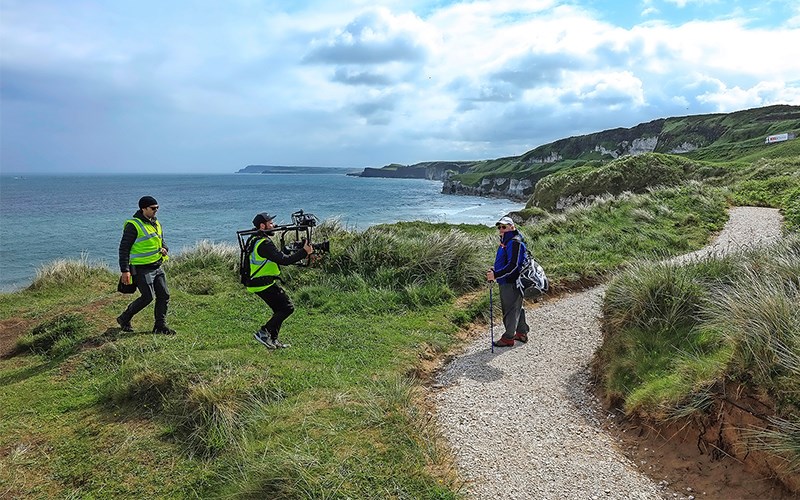
It was during a 12-day cancer charity trek to the Himalayas that he met Lynda Thomas, the head of Macmillan Cancer Support, and discussed using golf as a way to fight cancer. It was there that he came up with the idea of putting a cancer awareness message on a flag.
“Macmillan loved the idea, so we intended to present it to 50 or so golf clubs,” he explains. “That was in 2014. I then went down with head and neck cancer soon after… The whole idea went on the backburner during my recovery, but one good thing did come of it.
“I had a lot of time to think and got talking to a lot of people who liked the idea but were asking, why is it all in the UK? Their point was that there are 60 million golfers and cancer is such a global thing. That’s where GlobalGolf4Cancer was born.”
After having lymph nodes and his left parotid gland removed in 2014, as well as a tumour two years later, he was given the all-clear. Those two words, he says, gave him the green light to launch his campaign and walk 2,000km along the Wild Atlantic Way in the Republic of Ireland, stopping off to play the 4th hole at 40 golf clubs on route.
“There’s a great photograph of a golfer who’s silhouetted and walking with a golf bag on his back, towards a flag. I used that image as my inspiration. But I had no real preparation because I had my hip replaced three months previous. I was on crutches in January so my training was the walk itself, which started on March 4, 2017.”
When he did set off at Ireland’s most northerly point, Malin Head, he spent the next 56 days hiking across the coasts of Donegal, Sligo and Mayo counties, visiting 20 courses including Rosapenna and Carne.
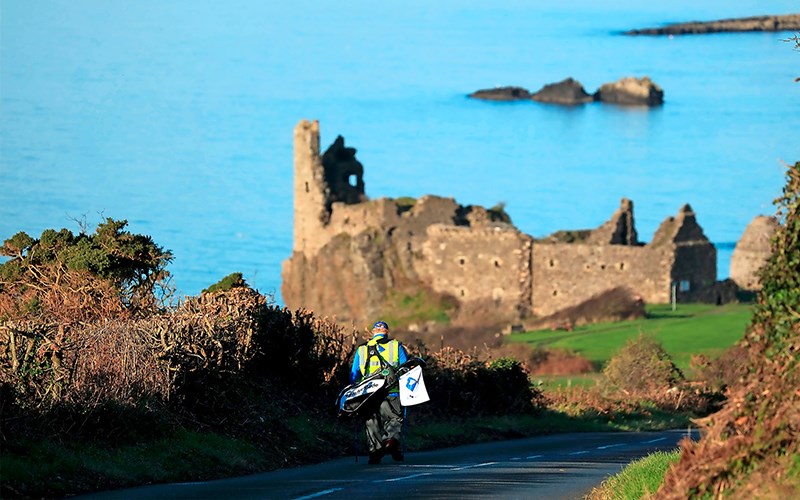
“I took the summer off to protect myself from the sun, but I had to delay the second half, walking from Galway to Old Head, because I got my second cancer situation,” he says. “I had a nine-and-a-half-hour scalp operation in November 2017, but the first thing I said to my surgeon was, ‘When will I be able to complete my walk?’”
He told him to rest for 90 days, but Edmund went against doctors’ orders and played in the Nadal and Olazabal Invitational three weeks later. He then resumed his walk 91 days after his operation.
“It was actually the anniversary of when I started,” he says. He eventually completed the journey on May 4, and then returned eight weeks later to fly the GlobalGolf4Cancer flag in the Irish Open Pro- Am at his home club of Ballyliffin. It was around the same time that he was diagnosed with cancer for a third time, forcing him to undergo surgery three times.
“I was in hospital for five days. I went in on September 11 – can you believe that? – but I was still able to start my second walk in Scotland on October 15 on the Ailsa course at Turnberry. People thought that I was mad.”
Against the odds, he summoned the strength to walk 260 miles in 40 days and visit 25 courses, including all seven of the nation’s past and present Open venues. Along the way, he crossed the Firth of Forth in a tiny, two-man boat – an experience he refers to as “the most frightening 50 minutes of my life” – and took a four week gap in the middle, during which he underwent yet more radiotherapy.
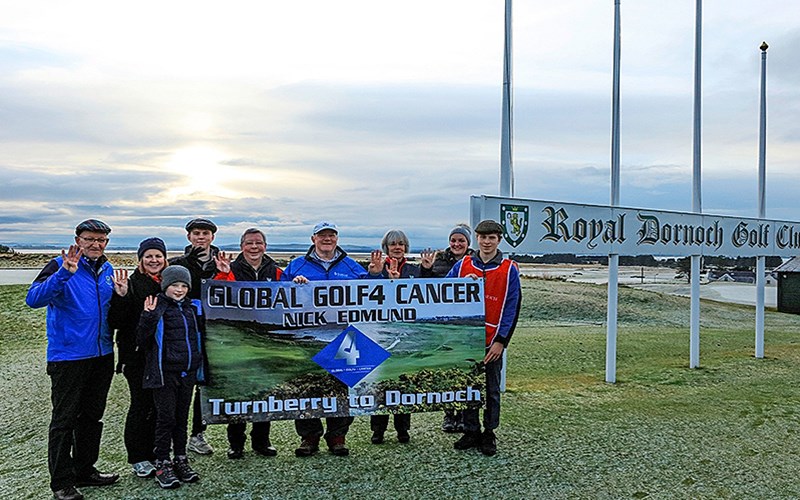
Amazingly, he resumed the walk three days later, and managed to finish three days before Christmas on the 4th green at Royal Dornoch. The personal highlight, he says, was playing the first four holes of the Old Course at St Andrews on St Andrew’s Day, with the two surgeons who had operated on him three times during the summer.
“That felt like a seminal moment. They saved my life,” says Edmund. “The fact they were happy to fly up from London and support me meant a lot. It was an emotional moment.”
Even so, was there ever a point when he felt like giving up?
“I never thought I would give up. But after day three on the Wild Atlantic Way, I was questioning how I was going to do it. Genuinely, I look back and think, gosh, how an earth did I walk all that way with a golf bag on my back? I’m 58 and I’m really not a great walker.
“It did feel like I was getting a helping hand. I’m not a spiritualistic kind of person, but I reckon 95 per cent of the time I had the wind behind me. I felt like I was being pushed.” He says he could give a number of examples, and starts by describing that third day in Ireland when he was faced with a 20km walk to Buncrana.
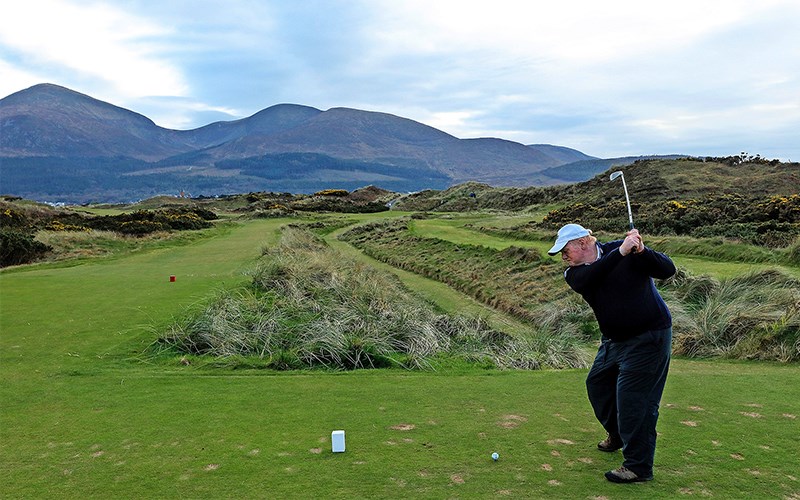
“I was on my own, feeling really sore, but every time I started doubting whether I could do it, somebody would come over to gee me up and give me that little boost. There was this one man – he was about 80 years old –and he looked like he had Parkinson’s. His hands were shaking and he walked up to me, offered me £20, and said in a stuttering way, ‘Shoot a 65 for me’. How can you not keep going after that?”
A mile short of his hotel, he then met “another angel” who walked with him all the way to the front door. “Before she left, I told her you’ve got to tell me your name. She said it was Gloria. It just had to be, didn’t it?” The stories keep on coming.
“I’ve played in blizzards and been drenched several times; I was once blown literally off my feet outside Waterville… I’ve experienced every condition imaginable but you know what, it’s all been worth it.”
He completed the third of his four golfing marathons this spring, walking 250 miles between Lough Erne – the Faldo Course he helped to create – and Royal County Down. He played 20 courses in total, including Royal Portrush where he made an “unconventional par” on the 4th.
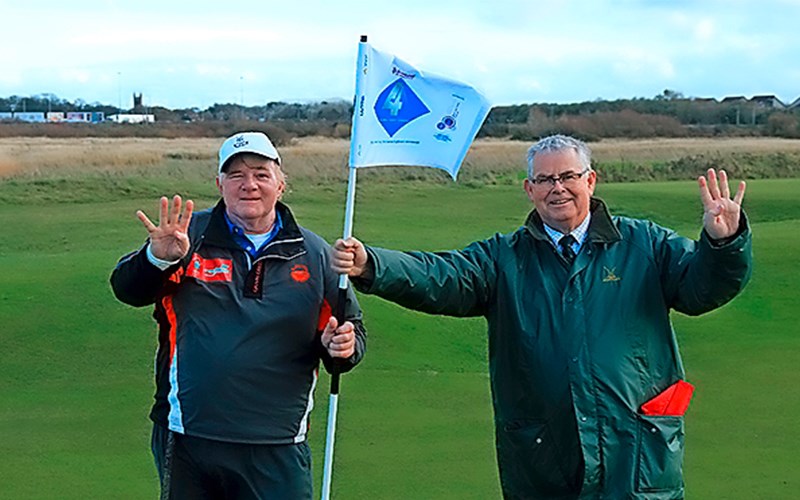
“It comprised two 5-irons and two 8-irons,” laughs Edmund. Since then, trips to The Masters and Open have followed and been sandwiched between hospital visits and more intrusive surgery.
He is grounded in London for the time being, but has a packed itinerary for the rest of this year and next. It includes a trip to South America in October, as well as a tour of northern Spain so he can tackle “a large golfing section” of the iconic Camino de Santiago pilgrimage route.
The longer-term goal, he says, is to see the GlobalGolf4Cancer flag flying across six continents, at as many as 500 courses by the end of 2021.
“I know that’s achievable,” he declares confidently, before reeling off a list of the clubs which have already pledged their support. They include Pebble Beach, Harbour Town, Royal Montreal and 20 courses in South Africa.
“We are making a difference,” he proclaims, “but we can always do more. That’s my mission. There are 60 million golfers out there. If just 1,000 of the 36,000 clubs worldwide could raise £1,000 a year, that’s £1 million which can go towards fighting cancer. That’s the message I’m trying to spread. It’s not about notoriety; it’s about the campaign and trying to change lives.”
